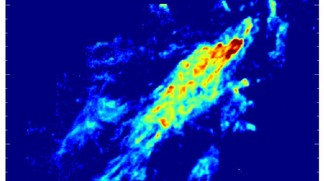May 27 2014
The Smith Cloud, a large gas cloud with enough gas to form two million suns, is on the verge of colliding with the Milky Way.
 © 2014 EPFL
© 2014 EPFL
While it will collide with the disk of the Galaxy in 10 million years, this will not be the first time it passes through the disk. According to its orbit the Smith Cloud will already have passed through the disk 70 million years ago. How the cloud managed to survive this last collision was investigated by an international team of astronomers from EPFL, Europe, Australia and America who found that a large amount of dark matter may be required to hold the cloud together through these passages.
Detailed observations over the last five years have suggested that the Smith Cloud currently interacting with the Milky Way as it approaches the disk. Remarkably, this is not the first time the cloud will collide with the Milky Way, with the cloud thought to have already passed through the disk of the Milky Way 70 million years ago. As the cloud moved through the disk it should rapidly be destroyed by drag.
How the Smith Cloud could survive this treacherous passage was studied by the team in a recent paper. For a normal gas cloud -- held together only by its own gravity -- the Smith Cloud would have to be three to four times bigger than is observed to survive this passage. However, such a cloud would also appear dramatically different, with smooth streams of gas leaving the main cloud, in contrast to the fragmented appearance of the actual cloud (seen in the inset picture). With a self-gravitating cloud considered unlikely to survive the passage the team instead considered what would happen if the cloud is instead encapsulated by a halo of dark matter similar to that which surrounds galaxies. In this case the Smith Cloud is not only able to survive the passage at its observed mass but it would also form the observed structure of the cloud with small parts of the cloud separated from the main bulk.
If the Smith Cloud does contain dark matter it would be the first example of a "failed" galaxy. Containing all the necessary ingredients to form the stars that make up a galaxy, but not enough gas and dark matter to start the inefficient process of star formation. It would also make it one of the best targets for one of many dark matter searches currently going on. As its closer than any galaxy, the authors were able to put limits on the properties of dark matter that are comparable to the best estimates arising from dwarf galaxies today.